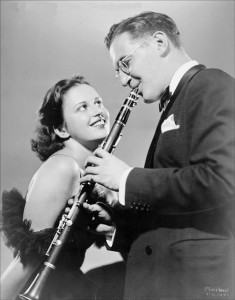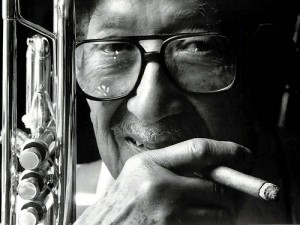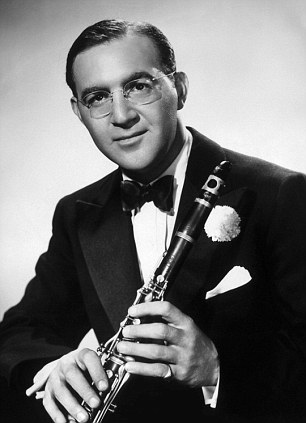
Benny Goodman. Photo courtesy dailymail.uk.
The clarinet virtuoso from Chicago became a central figure of the Swing Era, and popularized the jazz form with a worldwide audience in the 1930s and beyond.
To celebrate Benny Goodman's innovative style, Riverwalk Jazz has assembled performances and stories from our stable of jazz greats drawn into his orbit—Lionel Hampton, Doc Cheatham, Helen Ward—and our own Ron Hockett and Jim Cullum. In 20 years of Riverwalk Jazz radio broadcasts we've welcomed several artists closely associated with Goodman, or deeply influenced by his music, to The Landing in San Antonio.
One of the finest female vocalists of the era, Helen Ward joined Benny Goodman’s Let’s Dance radio program in 1934 and quickly became one of its star attractions.
Ward stayed with Benny through his meteoric rise to fame a couple years later. Her fresh, natural voice came across well on radio, and she was a heartthrob for the thousands of college boys who followed the band.
Late in her life Helen Ward spoke with us about Goodman with great warmth:
"Everyone who has worked with him...said that he was very difficult to get along with but Benny was a perfectionist, and I will stand up for him as long as I live that he was the fairest and most down-to-earth real kind of guy...I can recall so many things that nobody knows about, how many people Benny has helped financially, and Benny did it very quietly and I want that known, he was very generous that way."
Doc Cheatham (1905-1997) had a whole history of jazz under his belt, working with, among others, Gertrude 'Ma' Rainey, Cab Calloway and Teddy Wilson before he signed on to play in Benny Goodman’s Orchestra in the 1960s.
Talking with us at The Landing, Doc recalls Goodman's legendary perfectionism on the bandstand and his tendency to fire sidemen for perceived performance flaws.
"He was like that—he wasn’t a tough guy, he was a genius. His problem was he would hire sidemen like me, and we weren’t geniuses."
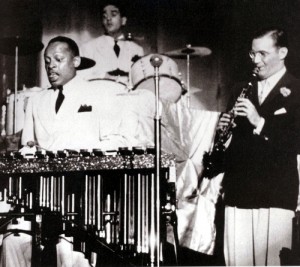
Benny Goodman, Lionel Hampton and Gene Krupa at the Paramount Theater in New York, 1937. Photo courtesy Frank Driggs Collection.
Benny Goodman was in Los Angeles performing at the Palomar Ballroom with his Orchestra in 1936 when his friend (the producer and concert promoter John Hammond) took him to see a young vibes player at a local club. They jammed together and the next day the Benny Goodman Quartet became ‘official’ when Lionel Hampton joined pianist Teddy Wilson, and drummer Gene Krupa on a recording session that produced "Moon Glow" and "Dinah."
Lionel reveals this about Goodman's style as a bandleader:
"You had to be very punctual when you played with Benny. You had to have your shoes shined and your suit pressed and come in with the brightness to play the best performance you could on your instrument. And I like that. That's the kind of band I try to have every day."
Jim Cullum Jazz Band reedman Ron Hockett explains Benny's career-long fondness for recording with small groups. "Benny really experienced the joy of making jazz in an intimate setting with his trio. I think he enjoyed that more than playing with the big band."
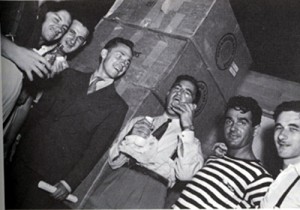
Backstage at the Camel Caravan: l to r, Allan Reuss, Ziggy Elman, Johnny Mercer, Benny Goodman, Gene Krupa and Murray MacEachern. Photo courtesy Gene Krupa.
Clarinetist Allan Vaché played in The Jim Cullum Jazz Band from 1975-1992, and recalled this story, told to him by his brother, trumpeter Warren Vaché, who played with Benny Goodman.
"Well, Benny in many ways was what Louis (Armstrong) was to the cornet or what Jack Teagarden was to the trombone. He was a trained musician, played classical music as well as jazz, and did things on the instrument that, up until that time, nobody had thought about doing in jazz.
My brother told me an interesting story that when Benny would rehearse in the back room, he'd sit back and pull out several reeds, and try each reed, one at a time. He'd put the reed on and hit a single tone and Warren told me it was the most pure tone he'd ever heard in his life. He said to Benny, 'How in the world do you do that?' Goodman said, 'Well you have to hear the sound in your head before you place it on the instrument.'"
Photo credit for Home Page: Benny Goodman with Charlie Christian on guitar and Georgie Auld on tenor. Photo courtesy mog.com.
Text based on Riverwalk Jazz script by Margaret Moos Pick ©2011


